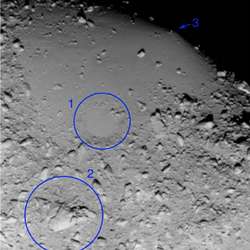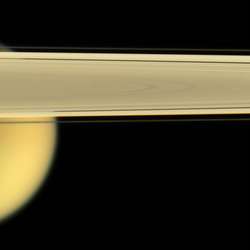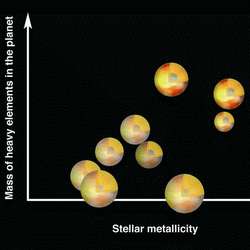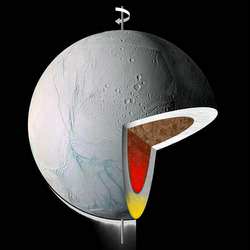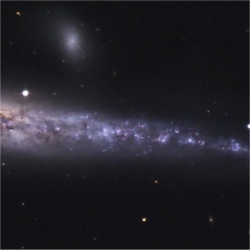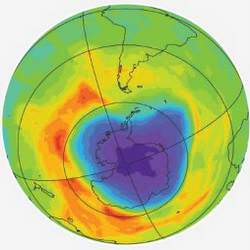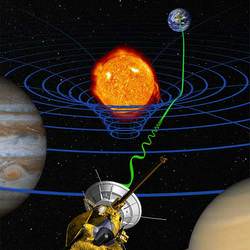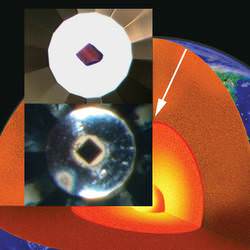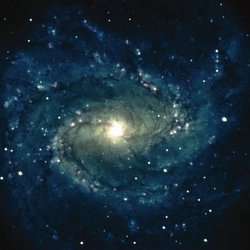
M83: “The Southern Pinwheel”. Image credit: Bill Schoening/NOAO/AURA/NSF. Click to enlarge.
Greetings, fellow SkyWatchers! Let’s hope clear skies have returned to your area as we begin the week with a look at the incredible M83. As the Moon returns, we’ll study the features and be in for some excitement as it occults asteroid Vesta. Stay tuned as we go globular and catch some “shooting stars” because…
Here’s what’s up!
Monday, May 29 – Today in 1919, a total eclipse of the Sun occurred and stellar measurements taken along the limb agreed with predictions based on Einstein’s General Relativity theory – a first! Although we call it gravity, the space-time curve deflects the light of stars near the limb, causing their apparent position to differ slightly. Unlike today’s astronomy, at that time you could only observe stars near the Sun’s limb (less than an arc second) during an eclipse. It’s interesting to note that even Newton had his own theories on light and gravitation which also predicted deflection!
With tonight’s thin moon setting early, let’s have a look at the superb “Southern Pinwheel” galaxy – M83. You’ll find it a little more than a fist width south-southeast of Gamma Hydrae.
Pictures of M83 are often used to show budding astronomers what our own galaxy would look like if it were “out there” rather than “all around us.” In astrophotos, M83 shows a luminous central core with two broad bars of almost equally intense light extending outward across from one another. These act as trunks for the gnarled growth of the galaxy’s main spiral arms. Well away from the core, three spiral extensions are seen coiling outward to ultimately dissipate into space. But, that’s where the comparison with our own galaxy ends. This 15 million light-year distant, 30,000 light-year diameter class SB spiral is but a miniature of our giant spiral!
As you observe M83 tonight take the time to look for the structure described above – the round central core region, lateral bars, and spiraling extensions. More aperture means more light, and more detail.
Something new? First re-locate M5 in Serpens then head 3 degrees east. There you will find the brightest galaxy (NGC 5846) of a half dozen or so clustered around 4.6 magnitude 110 Virginis. These include NGCs 5850, 5831, 5838, 5854, 5813, and NGC 5806. These seven galaxies range in magnitude from 10.2 to 11.8 – and all are within the range of a mid-size scope.
Tuesday, May 30 – Tonight we’ll begin our studies by checking out the slender crescent of the Moon. To the north you will see the eastern edge of Mare Crisium beginning to emerge. The bright point on the shoreline is Promontorium Agarum with shallow crater Condorcet to its east. Look along the shore of the mare for a mountain to the south known as Mons Usov. Just to its north Luna 24 landed and directly to its west are the remains of Luna 15. Can you spot tiny crater Fahrenheit nearby?
Once the Moon has set, let’s revisit a spectacular globular cluster well suited to all instruments – M5. To find M5 easily, head southeast of Arcturus and north of Beta Librae and identify 5 Serpentis. At low power, or in binoculars, you will see this handsome globular in the same field to the northwest.
First discovered while observing a comet by Gottfried Kirch and his wife in 1702, Charles Messier found it on his own on May 23, 1764. Although Messier said it was a round nebula that “doesn’t contain any stars,” even small scopes can resolve the curved patterns of stars that extend from M5’s bright nucleus. Binoculars will reveal it with ease. For a real challenge, large telescopes can look for 11.8 magnitude globular Palomar 5 about 40′ south of the star 4 Serpentis. Under very dark, clear skies, M5 can just be glimpsed unaided, but telescopes will enjoy the rose-petal like star arcs of this 13 billion year old city of stars.
Wednesday, May 31 – Be very sure to check with IOTA for an awesome event on this Universal date. Why? Asteroid Vesta will be occulted by the Moon!
Tonight let’s return to Mare Crisium and look for some challenging features. Beginning on the south shore of Crisium, start by identifying crater Shaply trapped on the edge of the mare’s enclosure. To the southeast of Shaply you will see two small grey ovals. The northernmost is crater Firmicus with crater Apollonius to its south. Further south you will see the smooth grey area of Sinus Successus. If you look at the paler peninsula on Successus’ northern shore, you are seeing crater Ameghino and the landing area of the Luna 18 and Luna 20 missions.
If you’d like to take on another mission tonight, wait for the Moon to set and head towards Hercules for a high power view of a 9th magnitude planetary nebula – NGC 6210. This small disk won’t be easy to separate from neighboring stars without magnification. To find NGC 6210, locate Beta and Gamma Herculis. Draw an imaginary line between them and extend it around the same distance to the northeast. Around 6500 light-years away, NGC 6510 is one of the most active planetary nebulae. Hubble Space Telescope (HST) images show powerful hot jets of turbulent gas burrowing through an outer shell of cool gas.
Thursday, June 1 – Tonight let’s look on the lunar surface at the junction of Mare Fecunditatis and the edge of Mare Tranquillitatis. Here stands ancient Taruntius. Like a lighthouse guarding the shores, it stands on a mountainous peninsula overlooking the mare. Tonight it appears as a bright ring, but watch in the days ahead as this “lighthouse” shoots its brilliant beams across the desolate landscape nearly 175 kilometers.
To see another brilliant lighthouse, let’s head towards northern Hercules for a look at “the other Hercules Cluster” – M92. Discovered on December 27, 1777 by J. E. Bode, magnitude 6.5 M92 radiates with roughly half the brilliance of the Great Hercules Cluster – and this holds true intrinsically as well. About 900 light-years more distant than its famous neighbor, M13, the smaller M92 is still only 5,000 light-years away – “next door.”
M92 gives a splendid, well-resolved view in even small scopes. It dissolves into dozens of fainter members arrayed around a nebulous core radiating the combined light of over 150,000 suns. Like all globulars, higher magnification must be used to add contrast and reveal some of its brighter stellar components – especially near the core where this celestial “lighthouse” really gathers them in!
Friday, June 2 – For SkyWatchers tonight, have a look as Regulus is quite near Luna.
For telescope users, the Moon gives a wonderful opportunity to revisit ancient crater Posidonius. Its 84 kilometer by 98 kilometer expanse is easily seen in the most modest of optical instruments and it offers a wealth of details with its eroded walls and 1768 meter (5800 ft.) central peak. Look for a central crater attended by a fine curve of challenging mountain peaks to its east.
Continue southward from Posidonius along the edge of Mare Serenitatis to catch partially open crater Le Monnier. This ruined ring contains the remains of the Luna 21 mission – forever awaiting salvage in the grey sands along Le Monnier’s southern edge.
Even though skies are fairly bright, we can still get an impression of a very distant third globular cluster in Hercules. This one is small and faint – but with reason. NGC 6229 is almost 100,000 light-years away! If it were transported to the distance of M13 or M92 it would shine as bright as the latter and eclipse both in apparent size!
Due to great distance, the brightest stars associated with NGC 6229 are only within reach of large telescopes. This may explain why William Herschel interpreted the faint and slightly condensed glow of NGC 6229 as a planetary nebula when he discovered it May 12, 1787. The surprise of three globulars within the confines of Hercules may also explain why the globular cluster was mistaken as a comet discovery in 1819! Its stellar nature was only first resolved in the mid 1800s by the discoverer of Neptune – Louis d’Arrest.
Despite the Moon, larger scopes can find NGC 6229 between the stars 52 and 42 Hercules, a fist width north of Eta – the northeastern star of the Hercules Keystone.
Saturday, June 3 – If you’re up early, why not keep watch for the peak of the Tau Herculids meteor shower? With a radiant near Corona Borealis, the Earth will encounter this stream for about a month. Sharp-eyed observers can expect about 15 faint streaks per hour at its maximum.
Although it’s furthest from the Earth right now, did you see Selene during daylight today? Spectacular, isn’t it. Have you ever wondered if there was any place on the lunar surface that has never seen the light?
Directly in the center of the Moon is a dark floored area known as the Sinus Medii. South of that are two conspicuously large craters – Hipparchus to the north and ancient Albategnius to the south. Trace the terminator toward the south until you almost reach its point (cusp.) There you will see a black oval. This normal looking crater with brilliant west wall is ancient crater Curtius. Because of its high latitude, we never see its interior – and neither does the Sun! It is believed that the inner walls are quite steep. Because of this, Curtius’ deep interior hasn’t seen the light of day since its formation billions of years ago! Locked in perpetual darkness, scientists speculate there may be “lunar ice” inside its many cracks and crevasses crevices.
Because our Moon has no atmosphere, the entire surface is exposed to the vacuum of space. When sunlit, the surface reaches up to 385 K. Any exposed ice would immediately evaporate and be lost because the Moon’s weak gravity cannot hold it. Frozen matter can only exist on the moon within permanently shadowed areas. Curtius lies near the Moon’s south pole. Imaging has shown some 15,000 square kilometers where similar conditions could exist. But where does the “ice” come from? The lunar surface never ceases to be pelted by meteorites – most of which contain water. Many craters are formed by just such impacts. Hidden from sunlight, this frozen material can exist for millions of years!
Sunday, June 4 – How about a little lunar “prospecting?” Then let’s explore the northern equivalent to Curtius. Start by locating previous study crater Plato. North of Plato lies a long horizontal area of gray floor – Mare Frigoris. North of Frigoris you will see a “double crater.” This is the elongated diamond shape of Goldschmidt. Cutting across its western border is Anaxagoras. The lunar north pole isn’t far from Goldschmidt, and since Anaxagoras lies about one degree outside of the Moon’s theoretical “arctic” area, the lunar sun will never go high enough to clear the southernmost rim. Such “permanent darkness” must mean there’s ice! And for that very reason, NASA’s Lunar Prospector probe was sent to explore. Did it find what it was looking for? The answer is yes.
The probe discovered vast quantities of cometary ice secreted inside the crater’s depths. What’s the significance? Water is essential to life and its presence influences any plans to establish a base on the lunar surface. Will the sun ever shine on such a base? Quite probably. But down below, in the crater’s depths it never has, and never will…
Tonight let’s look at another distant world as we take another look at Jupiter. You don’t have to wait for the sky to actually get dark to view Jupiter. At magnitude -2.4, Jupiter can easily be found a half-hour after sunset. It won’t be long before it’s gone so enjoy those “Bands on the Run” while they last!
May all your journeys be at light speed… ~Tammy Plotner with Jeff Barbour.
